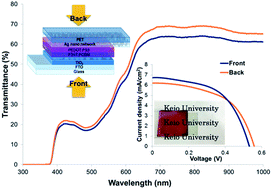Semitransparent polymer-based solar cells are renewable, lightweight and low-cost energy sources and are attracting increasing attention in terms of both pure scientific research and commercial applications. The carrier transport layer in most polymer solar cells is composed of a TiO2 layer, and the thickness and homogeneity of this layer strongly influence the cell's power conversion efficiency. However, despite considerable development efforts, it is difficult to produce precisely-controlled TiO2 layers at room temperature with low fabrication times and without using materials that are toxic to humans. Here, we demonstrate semitransparent polymer-based solar cells fabricated via a simple wet lamination process with a TiO2 layer produced by an automatic spray layer-by-layer (spray-LBL) self-assembly method for improved solar cells. The spray-LBL method produced nano-ordered precursor films, composed of the non-toxic materials poly(diallyldimethylammonium chloride) (PDDA) and titanium(IV) bis(ammonium lactato) dihydroxide (TALH), from water solutions with high uniformity in a short fabrication time, and these films were then annealed to transform them into TiO2 layers at different temperatures. After TiO2 layer preparation, the polymer solar cells were fabricated via a lamination process. The resulting cells were semitransparent and generated electricity by using the incident light from both the front and back sides. These semitransparent polymer-based solar cells produced power conversion efficiencies of more than 2% by varying the TiO2 layer thickness via control of the spray-LBL process and the annealing temperature.

